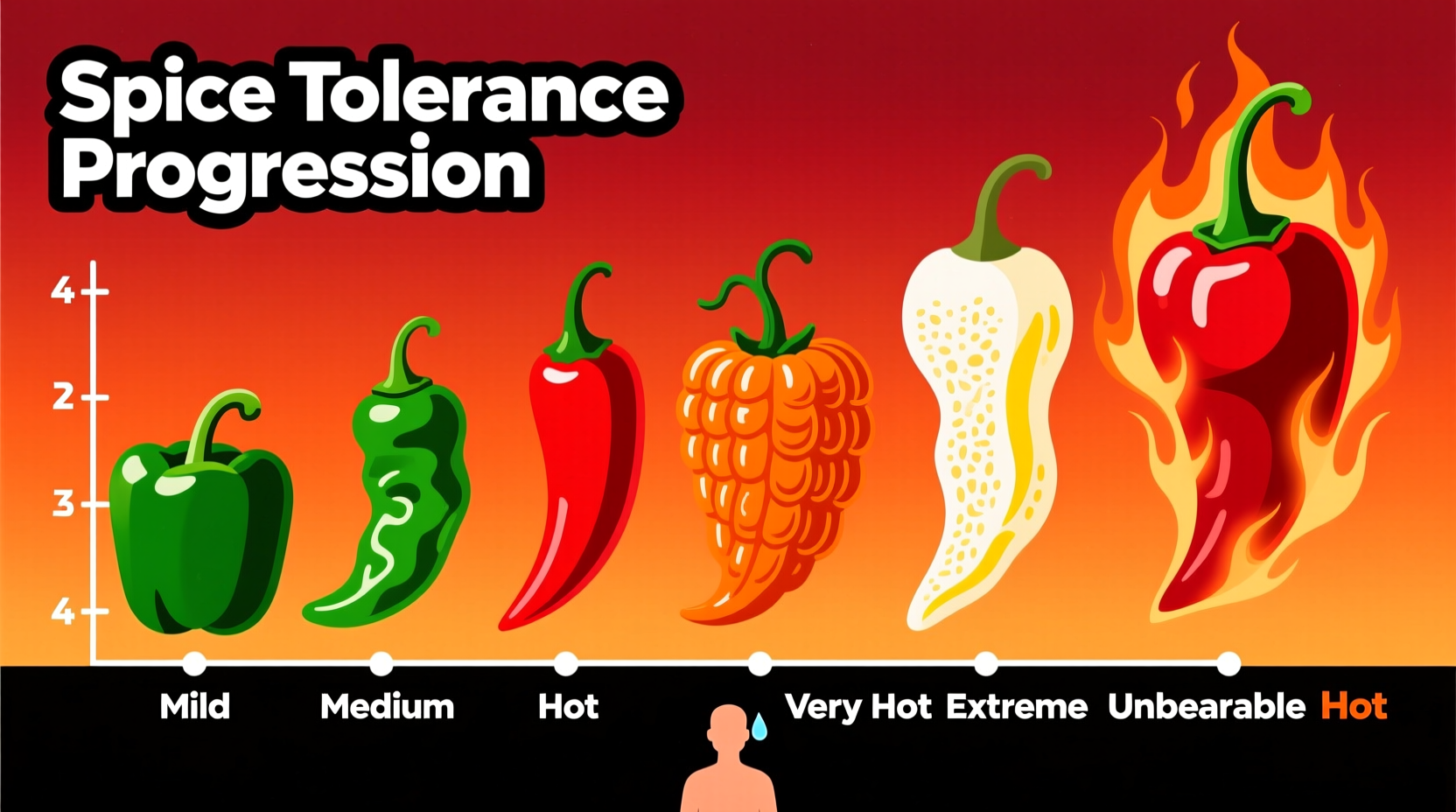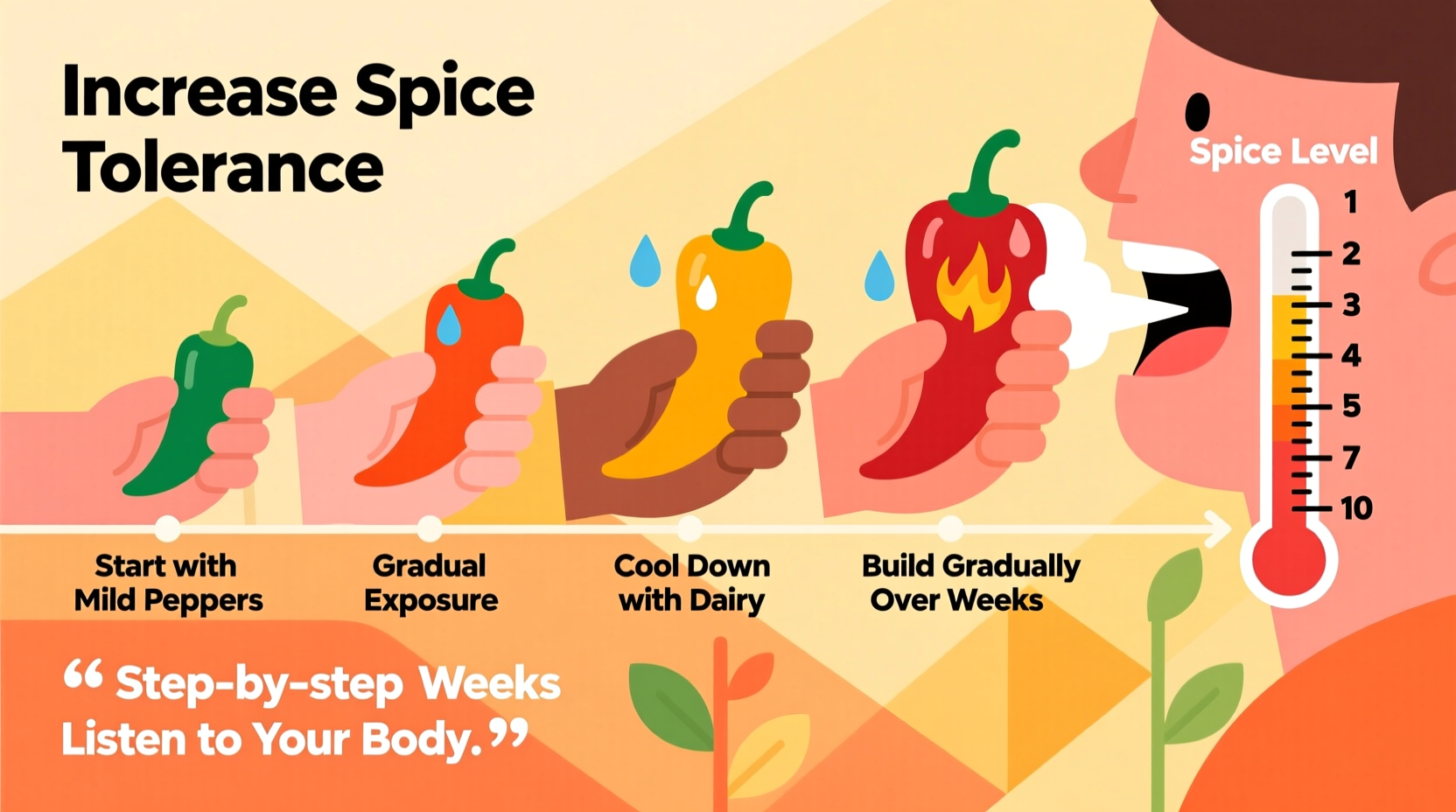Ever ordered "mild" salsa only to reach for eight glasses of water? You're not alone. Nearly 67% of Americans struggle with spicy foods, according to a 2018 National Institutes of Health study. The good news: spice tolerance isn't fixed. Through understanding capsaicin biology and applying strategic exposure techniques, you can transform your relationship with heat—safely and effectively.
The Science Behind Spice Tolerance
Capsaicin—the compound that makes chili peppers hot—triggers TRPV1 receptors designed to detect actual heat damage. When activated, these receptors send pain signals to your brain. Tolerance develops when repeated exposure causes temporary receptor desensitization, not permanent damage. A 2015 Physiology & Behavior study confirmed this adaptation occurs within nerve endings in your mouth, not through psychological conditioning alone.
| Effective Method | Ineffective Method | Why It Matters |
|---|---|---|
| Gradual weekly increases (10-20%) | Sudden large jumps in heat | Prevents receptor overload and negative associations |
| Dairy pairing during consumption | Water or alcohol for relief | Casein binds to capsaicin; water spreads oil-based compound |
| Consistent exposure (3-4x/week) | Irregular spicy meals | Maintains receptor adaptation without regression |
Your 6-Week Spice Tolerance Timeline
Building tolerance follows a predictable biological pattern. This evidence-based progression plan aligns with receptor adaptation research from the Frontiers in Neuroscience Journal:
- Weeks 1-2: Foundation Building
- Start with 100-500 Scoville Unit peppers (poblano, banana pepper)
- Consume 3x weekly with full-fat dairy (Greek yogurt works best)
- Limit to 1/4 pepper per meal initially
- Weeks 3-4: Controlled Exposure
- Increase to 1,000-5,000 Scoville Units (jalapeño, serrano)
- Mix peppers with familiar foods (add to scrambled eggs)
- Practice controlled breathing during consumption
- Weeks 5-6: Integration Phase
- Experiment with 10,000-30,000 Scoville Units (cayenne, Thai chili)
- Try authentic regional preparations (not just hot sauce)
- Notice flavor complexity beyond heat
Critical Context Boundaries: When Not to Push Limits
While most healthy adults can safely build tolerance, certain conditions require caution:
- Gastrointestinal issues: Those with IBS or ulcers should consult a physician before increasing spice intake, as capsaicin may exacerbate symptoms according to Mayo Clinic guidelines
- Medication interactions: Capsaicin affects blood thinners and diabetes medications
- Genetic factors: Approximately 25% of people have naturally fewer TRPV1 receptors, creating lower biological ceilings

Strategic Food Pairing Techniques
What you eat with spicy foods matters more than most realize. Research from the Journal of Agricultural and Food Chemistry shows:
- Dairy superiority: Full-fat dairy contains casein that binds to capsaicin molecules 3x more effectively than low-fat alternatives
- Timing matters: Consume dairy with spicy food, not after—prevents initial receptor activation
- Smart substitutions: Mango lassi cools better than plain yogurt due to fruit sugars binding additional capsaicin
- Avoid: Carbonated beverages spread capsaicin oil throughout your mouth
Advanced Tolerance Building Strategies
Once past the beginner stage, implement these professional chef techniques:
- Flavor-focused approach: Shift attention from heat to flavor profiles—habaneros offer tropical fruit notes beyond Scoville ratings
- Temperature control: Serve spicy dishes slightly cooler (120°F/49°C) to reduce initial burn sensation
- Oil management: Blot excess oil from spicy dishes with bread to reduce capsaicin concentration
- Recovery protocol: Post-meal dairy consumption maintains receptor adaptation between sessions
Recognizing Plateaus and Biological Limits
If progress stalls after 8 weeks, you've likely hit one of three barriers:
- Exposure inconsistency: Missing more than 2 sessions weekly resets adaptation
- Nutritional deficiency: Zinc deficiency impairs TRPV1 receptor function (common in vegetarians)
- Genetic ceiling: Some individuals naturally max out around 50,000 Scoville Units
Instead of pushing through plateaus, focus on flavor appreciation. As Chef Liu Wei notes: "True spice mastery isn't about enduring pain—it's recognizing 23 distinct flavor notes within heat. Many world-class chefs never progress beyond medium heat but create extraordinary dishes through nuanced understanding."
FAQ: Building Spice Tolerance
How quickly can I realistically increase my spice tolerance?
Most people safely double their tolerance within 4-6 weeks using gradual exposure (10-20% weekly increases). Significant changes become noticeable around week 3 as TRPV1 receptors adapt. Complete transformation to handling extremely spicy foods typically takes 2-3 months of consistent practice.
Does drinking milk really help with spicy food?
Yes, but full-fat dairy works best. Casein protein binds to capsaicin molecules more effectively than water or alcohol. Whole milk provides 3x better relief than skim milk due to fat content that dissolves the oil-based capsaicin. For immediate relief, consume dairy during the spicy meal rather than after.
Can children build spice tolerance safely?
Pediatric nutritionists recommend waiting until age 5 before introducing mild spices. Children's TRPV1 receptors are more sensitive, and their smaller body mass means capsaicin concentration affects them more strongly. Always pair with substantial dairy and keep initial exposure below 500 Scoville units (like mild paprika).
Why do some people naturally handle spice better?
Genetic variations in TRPV1 receptor density account for approximately 50% of tolerance differences. Populations with historical chili consumption (like Mexico and Thailand) show higher average tolerance due to both genetic adaptation and early dietary exposure. Zinc levels also impact receptor function—deficiency creates lower baseline tolerance.











 浙公网安备
33010002000092号
浙公网安备
33010002000092号 浙B2-20120091-4
浙B2-20120091-4